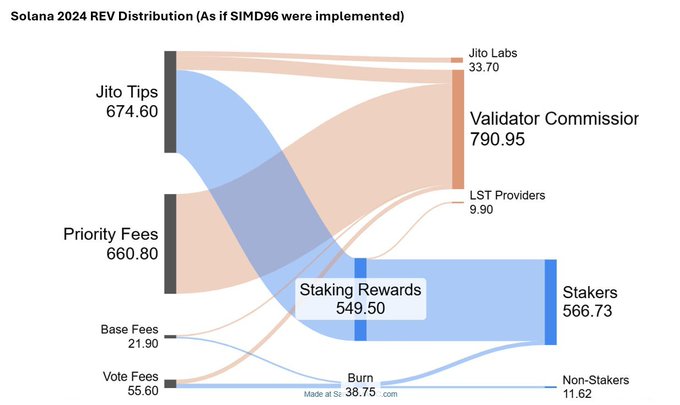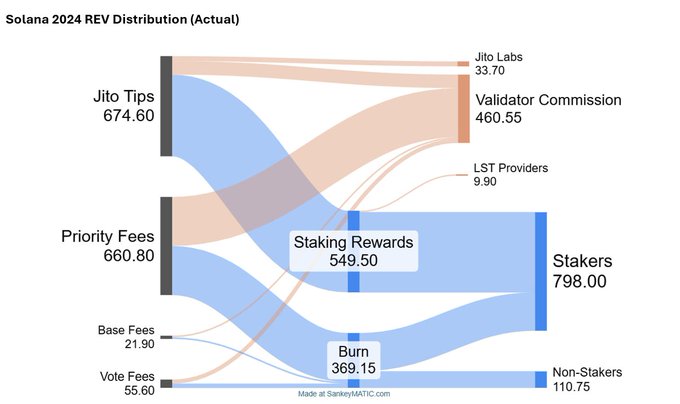- Published on
Solana Activates SIMD-96: Turning Point in Charge Mechanism and LST Yield War
- Authors

- Name
- Administrator
- @airdropdecks
How does SIMD-96 change the rules of trading fees on Solana and what does this mean for users and investors?
The Solana network has just officially activated SIMD-96, an important change in the transaction fee mechanism, which is expected to make major impacts on the Solana ecosystem, especially in the Staking sector.
This update not only changes the way fees are distributed across the network, but could also open up a competition for Staking Yield (LST) among validators.
SIMD-96: Change the rules of the game, redistribute benefits
To better understand SIMD-96 and its implications, users first need to master the current transaction fee mechanism on Solana. The special feature of Solana compared to other blockchains such as Ethereum is the use of Local fee markets.
Specifically, each transaction on Solana pays a base fee of 0.000005 SOL. However, during times when the network is overloaded, users need to pay extra priority fees so that their transactions are processed quickly.
Before SIMD-96 is activated, the priority fee on Solana is divided into two parts: 50% is burned (permanently removed from the supply) and the remaining 50% is distributed to the validators who process the transaction.
SIMD-96 has made a big change: 100% of the priority fee will now belong to the authenticator, no longer partially burned. This change is predicted to have a significant impact on the economic model of validators, while affecting the entire Solana ecosystem.

Effect of SIMD-96 on validator profitability and APY staking
On the Solana network, the authenticator has three main sources of income:
- Release bonus: When a validator creates a new block, they are rewarded with SOL. This is the basic block bonus.
- MEV (Miner Extractable Value): Profit is obtained from the arrangement of the order of transactions.
- Priority fee:As mentioned, previously the authenticator received only 50% of the priority fee, but with SIMD-96 they would receive the full 100%.
The complete elimination of the burned priority fee will increase profitability for authenticators. This also means that the APY (Annual Percentage Yield), which is the annual return that users receive when participating in staking, has the potential to increase significantly.
In the past, when priority fees were burned at half, users and authenticators often “circumvented the law” by making separate agreements outside the network (off-chain) to minimize the cost loss. This creates a lack of transparency and can lead to unfair behaviors.
SIMD-96 solves this problem by bringing all priority fee-related activity onto the blockchain (on-chain), where every transaction is publicly and transparently recorded. This solution eliminates implicit agreements, ensures every user is treated fairly and the system works more efficiently.
SIMD-123: The Missing Piece for the Solana Economic Picture
Besides SIMD-96, the Solana community is also very interested in SIMD-123, another proposal related to the charging mechanism. While SIMD-96 eliminates priority fee burning, SIMD-123 adds a protocol-level fee sharing mechanism with staking participants.
Many argue that the simultaneous deployment of both SIMD-96 and SIMD-123 is essential to ensure balance in the Solana ecosystem.
With SIMD-96 only, authenticators would benefit too much from transaction fees, while SOL token holders would be marginalized. SIMD-123 will help realign this distribution of benefits, ensuring that users who participate in staking also benefit from the growth of the network.
The change in fee mechanism brought about by SIMD-96 is expected to create a “race” between validators in attracting users to participate in staking. To optimize profits from transaction fees, validators will have to compete with each other by offering attractive profit-sharing programs for users.
Jito Labs' TipRuter is a good example of this trend. This tool allows the authenticator to automatically share fees with the stakeholder. Currently, some validators have begun deploying profit-sharing programs through LST pools such as Helius Labs' HSOL, and more are expected to join in the near future.

This competition is expected to bring tremendous benefits to users participating in staking, driving APY soaring and spurring the growth of the Staking ecosystem on Solana.
In summary, SIMD-96 is an important turning point in Solana's transaction fee mechanism, creating major changes in profit distribution and fostering competition among validators. Combined with SIMD-123, this update will create a more engaging Staking environment, engaging users and contributing to the sustainable development of the Solana network.


